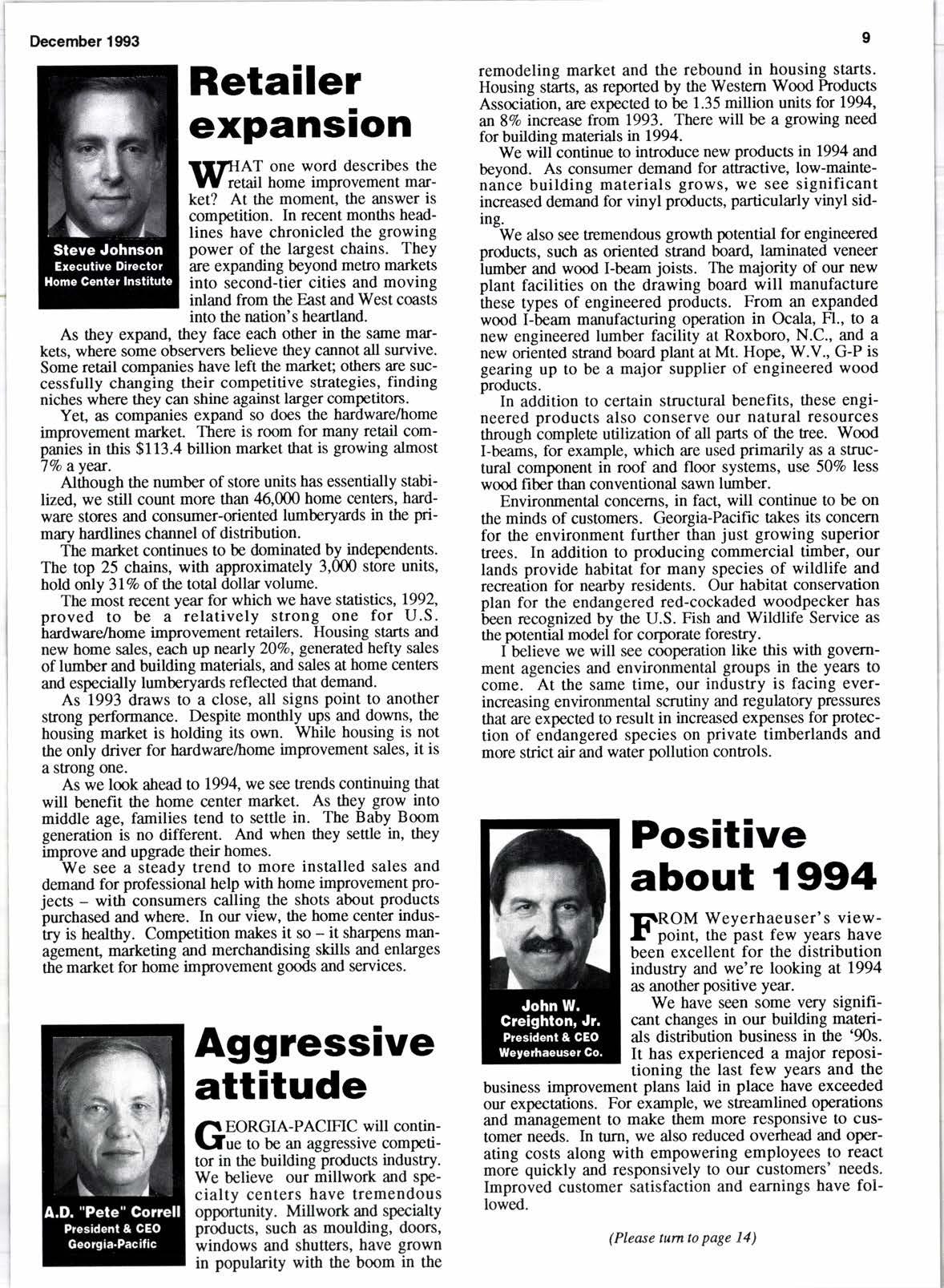
3 minute read
Retailer expanslon
w**;ififfi"*ff$,ffffi:Ht*: ket? At the moment, the answer is competition. In recent months headlines have chronicled the growing power of the largest chains. They are expanding beyond metro nwkets into second-tier cities and moving inland from the East and West coasts into the nation's heartland.
As they expand, they face each other in the same markets, where some observers believe they cannot all survive. Some retail companies have left the mafteq others are successfully changing their competitive strategies, finding niches where they can shine against larger competitors.
Yet, as companies expand so does the hardware/home improvement markeL There is room for many retail companies in this $113.4 billion market that is growing almost 77o aleal.
Although the number of store units has essentially stabilized, we still count more than 46,000 home centen, hardware sttres and consumer-oriented lumberyards in the p,rimry hardlines channel of distribution.
The market continues to be dominated by independents. The top 25 chains, with approximately 3,000 store units, hold only 3lVo of the total dollar volume.
The niost recent year for which we have statistics, 1992, proved to be a- relatively strong one for U.S. hardware/home improvement retailers. Housing starts and new home sales, each up neady 20Vo, flenmated hefty sales of lumber and building materials, and sales at home centers and especially lumberyards reflected that denand.
As 1993 draws to a close, all signs point to another strong perforrrance. Despite nonthly ups and downs, the housing market is holding its own. While housing is not the only driver for hardware/home improvement sales, it is a strong one.
As we lmk ahead to 1994, we see trends continuing that will benefit the home center market. As they grow into middle age, families tend to settle in. The Baby Boom generation is no different. And when they settle in, they imorove and uosrade their homes.
'We see a si6ady trend to more installed sales and demand for professional help with home improvement projects - with consumers calling the shots about products purchased and where. In our view, the home center industry is healthy. Competition makes it so - it sharpens managemen! marketing and merchandising skills and enlarges t[e market for home improvement goods and services.
Aggressive attitude
EORGIA-PACIFIC will continlJue to be an aggressive competitor in the building products industry.
We believe our millwork and specialty centers have tremendous opportunity. Millwork and specialty products, such as moulding, doors, windows and shutters, have grown in popularity with the boom in the remodeling market and the rebound in housing starts. Housing starts, as reported by the Western Wood Products Association, are expected to be 1.35 million units for 1994, an 87o increase from 1993. There will be a growing need forbuilding materials in 1994.
We willcontinue to introduce new producs in 1994 and beyond. As consumer demand for atlractive, low-maintenance building materials grows, we see significant inoeased demand for vinyl products, particularly vinyl siding.-We also see Eemendous growth potential for engineercd products, such as oriented stJand boar( laminated veneer lumber and wood l-beam joists. The majority of our new plant facilities on the drawing board will manufacture tacllltres orawmg Doaro wrll manuracture ihese types of engineered products. From an expanded wcnd T-beam manufacturins oDeration in Ocala. Fl.. to a wood l-beam manufacturing operation Ocala, Fl., new ensineered lumber facilitv at Roxboro, N.C., a new engineered faCility and a new oriented strand board plant at Mt. Hope, W.V., G-P is gearing up to be a major supplier of engineered wood products.
-
In addition to certain structural benefits, these engineered products also conserve our natural resources thrcugh complete utilization of dl parts of the ree. Wood I-beams, for example, which are used primarily as a structural component in roof and floor systems, use 507o less wood fiber than conventional sawn lumber.
Envirorunental concems, in fact, will continue to be on the minds of customers. Georgia-Pacific takes its concern for the environment further than just growing superior trees. In addition to producing commercial timber, our lands provide habitat for many species of wildlife and recreation for nearby residents. Our habitat conservation plan for the endangered red-cockaded woodpecker has been recognizedby the U.S. Fish and Wildlife Service as the potential model for corporate forestry.
I believe we will see cooperation like this with government agencies and environmental groups in the years to come. At the same time, our industry is facing everinoeasing environmental scrutiny and regulatory pressures that are expected to result in increased expenses for protection of endangered species on private timberlands and more strict air and water pollution controls.
Positive about 1994
ErROM Weyerhaeuser' s view-
I' point, the past few years have been excellent for the distribution industry and we're looking at 1994 as another positive year.
We have seen some very significant changes in our building materials distribution business in the '90s. It has experienced a major repositioning the last few years and the business improvement plans laid in place have exceeded our expectations. For example, we strearnlined operations and management to make Oem more responsive to customer needs. In turn, we also reduced overhead and operating costs along with empowering employees to react more quickly and responsively to our customers' needs. Improved customer satisfaction and earnings have followed.
(Please tumto page 14) af-

